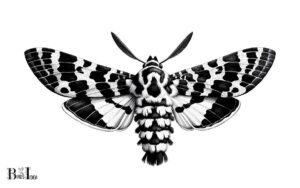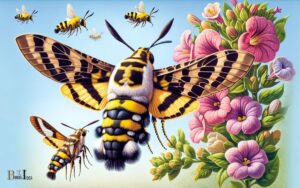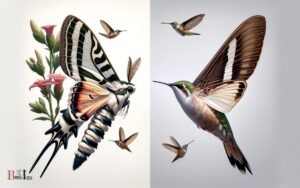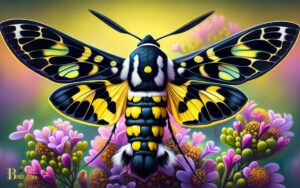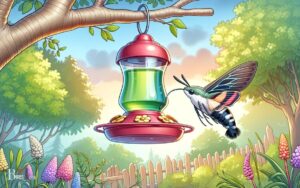Hummingbird Moth with Yellow Stripes: Discover the Beauty!
Coincidentally mistaken for hummingbirds, the hummingbird moth with yellow stripes is a fascinating insect that captures the curiosity of nature enthusiasts.
With its rapid wingbeats and hovering capabilities, this moth closely resembles its avian namesake. Its vibrant yellow stripes and furry body make it a striking sight as it flits from flower to flower.
Found in various habitats across North America, these moths play a crucial role in pollination, making them an essential part of the ecosystem.
Understanding their behaviors and characteristics provides insight into the delicate balance of nature.
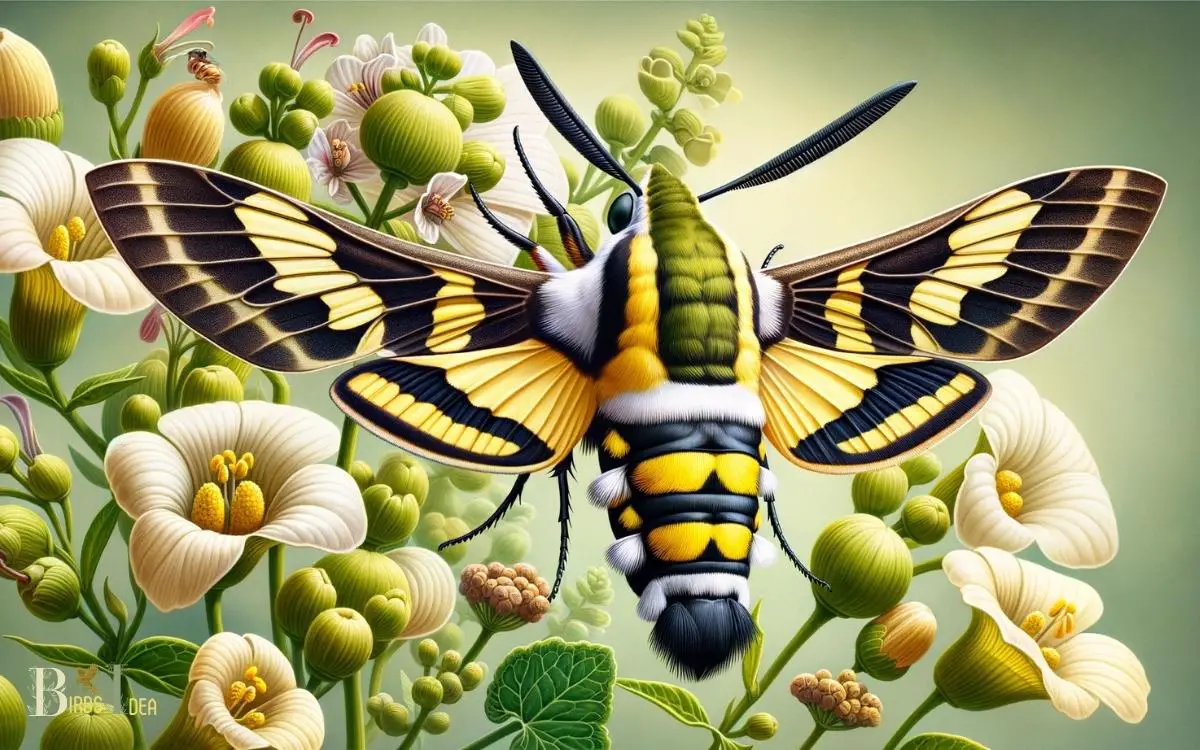
Key Takeaway
Physical Characteristics of Hummingbird Moths
The Hummingbird Moth has six distinct physical characteristics that distinguish it from other moth species.
- Firstly, it boasts a plump, furry body resembling that of a bumblebee.
- Secondly, its wings are transparent and lack the dusty scales found in typical moths.
- Thirdly, it has a rapid and agile flight pattern, akin to that of a hummingbird.
- Fourthly, its long proboscis, or feeding tube, allows it to feed on nectar from deep flowers.
- Fifthly, its vibrant coloration, often featuring yellow stripes, aids in its mimicry of a hummingbird.
- Lastly, its large, prominent eyes provide excellent vision, which is crucial for navigating during its daytime feeding hours.
These characteristics collectively make the Hummingbird Moth a unique and intriguing species within the moth family.
Habitat and Distribution
Endowed with a wide range of habitats, Hummingbird Moths can be found across various regions, from temperate forests to tropical areas.
- Temperate Forests: Hummingbird Moths thrive in temperate regions with moderate climates and abundant vegetation, where they can find ample nectar sources and suitable breeding grounds.
- Grasslands: These moths are also commonly found in grasslands and meadows, where they can feed on the nectar of wildflowers and other flowering plants.
- Tropical Areas: In tropical regions, Hummingbird Moths can be spotted in lush rainforests and tropical gardens, where they’ve access to a diverse array of flowering plants for sustenance.
Their adaptable nature allows them to inhabit a wide range of environments, ensuring their presence in diverse ecosystems. This adaptability also plays a significant role in their feeding behaviors.
Feeding Behaviors
Adapted to their diverse habitats, Hummingbird Moths frequently visit flowering plants in search of nectar for sustenance.
Their feeding behaviors are characterized by hovering in front of flowers and using their long proboscis to sip nectar while in flight, much like their avian counterparts.
This unique feeding behavior allows them to access nectar from deep floral tubes, which other insects may not be able to reach.
Additionally, their rapid wing movements while feeding further mimic the actions of hummingbirds, reinforcing their bird-like appearance.
Hummingbird Moths are also known to be important pollinators as they transfer pollen from one flower to another while feeding, contributing to the reproductive success of the plants they visit.
This feeding behavior is crucial in understanding the role of Hummingbird Moths in the ecosystems they inhabit, and it directly impacts their life cycle and reproduction.
Life Cycle and Reproduction
The life cycle and reproduction of the hummingbird moth are fascinating aspects of its biology.
Mating and egg-laying behavior, metamorphosis stages, and factors influencing reproductive success are key points to explore.
Understanding these processes provides valuable insights into the survival and sustainability of this unique species.
Mating and Egg-Laying Behavior
One female hummingbird moth typically lays between 200 to 300 eggs during her lifespan.
After mating, the female seeks out suitable host plants, such as honeysuckle or hollyhock, to lay her eggs on.
The life cycle of the hummingbird moth consists of four stages: egg, larva, pupa, and adult. The eggs hatch into larvae, which then feed on the host plants before pupating.
Once they emerge as adults, the process of mating and egg-laying begins anew. The mating behavior of hummingbird moths involves aerial courtship displays, with the male actively pursuing the female.
After mating, the female will carefully select appropriate locations on the host plants to lay her eggs, ensuring the survival of the next generation.
Metamorphosis Stages Explained
During mating, the female hummingbird moth carefully selects suitable locations on host plants to lay her eggs, ensuring the survival of the next generation.
The metamorphosis of a hummingbird moth involves four distinct stages: egg, larva (caterpillar), pupa (chrysalis), and adult.
Each stage plays a crucial role in the life cycle and reproduction of these fascinating creatures.
The table below provides a visual representation of the metamorphosis stages:
| Stage | Description | Duration |
|---|---|---|
| Egg | Laid on the underside of host plant leaves, hatching into larvae within 4-10 days. | 4-10 days |
| Larva (Caterpillar) | Feeds voraciously on host plants, growing rapidly and molting several times to accommodate growth. | 2-4 weeks |
| Pupa (Chrysalis) | The transformative stage where the larva undergoes metamorphosis into an adult moth. | 10-20 days |
| Adult | Emerges from the chrysalis, ready to mate and repeat the life cycle. | 1-2 weeks |
Understanding these stages sheds light on the remarkable life cycle and reproduction of the hummingbird moth.
Factors Influencing Reproductive Success
As the female hummingbird moth selects suitable locations to lay her eggs, environmental conditions significantly influence her reproductive success.
Factors influencing the reproductive success of these moths include:
- Host plant availability: The presence of suitable host plants, such as honeysuckle or hawthorn, is crucial for the survival of hummingbird moth larvae. The availability of these plants directly impacts the likelihood of successful egg-laying and subsequent caterpillar development.
- Weather conditions: Temperature, humidity, and rainfall can all affect the survival of eggs and larvae. Extreme temperatures or prolonged periods of adverse weather can decrease the chances of successful reproduction.
- Predation and parasitism: The presence of predators and parasitic insects can pose significant threats to the reproductive success of hummingbird moths, as they may consume eggs or larvae.
These factors play a crucial role in determining the reproductive success of hummingbird moths.
Transitioning into the subsequent section about ‘predators and defense mechanisms’, it becomes evident that these environmental factors also influence the development of defense mechanisms in these moths.
Predators and Defense Mechanisms
The hummingbird moth’s defense mechanisms include rapid flight and evasive maneuvers to avoid predators.
With a wingspan of 1.6 to 1.8 inches, these moths are agile fliers, capable of sudden changes in direction and speed.
Their ability to hover in mid-air, similar to hummingbirds, makes them difficult targets for predators.
Additionally, their yellow stripes help them blend in with their surroundings, making it challenging for predators to spot them against the backdrop of flowers and foliage.
When threatened, they can also emit a clicking sound by rubbing their wings together, startling potential predators.
These defense mechanisms allow the hummingbird moth to evade capture by birds, bats, and other insectivores, contributing to their survival in diverse habitats.
Importance in Pollination
The hummingbird moth’s importance in pollination can’t be overstated. Its efficient pollination, compared to other pollinators, plays a crucial role in preserving plant diversity and maintaining ecosystem health.
Pollination Efficiency Comparison
Efficient pollination is crucial for the reproduction of many plant species. The importance of pollination efficiency is highlighted by the role of hummingbird moths with yellow stripes in this process.
When comparing pollination efficiency, the following points are essential to consider:
- Speed: Some pollinators, like bees, are faster at moving between flowers. Hummingbird moths, on the other hand, are slower but can cover longer distances in search of nectar.
- Precision: Bees are known for their precision in transferring pollen from one flower to another. Hummingbird moths may be less accurate in this regard.
- Frequency: Bees visit flowers more frequently, making them more consistent pollinators. Hummingbird moths may visit flowers less often but cover greater distances.
Understanding these factors helps in evaluating the overall impact of different pollinators on plant reproduction.
This comparison underscores the significance of pollination efficiency in maintaining plant diversity and ecosystem balance.
Plant Diversity Preservation
Importance of preserving plant diversity in pollination is evident in the intricate relationships between various plant species and their pollinators.
By maintaining a wide variety of plant species, the likelihood of providing suitable habitats and food sources for diverse pollinators increases.
This, in turn, ensures that pollinators such as bees, butterflies, and hummingbird moths have access to the nectar and pollen they need to survive and thrive.
Plant diversity also plays a crucial role in ensuring year-round availability of floral resources for pollinators, contributing to the stability of ecosystems.
Moreover, preserving plant diversity safeguards against the decline or loss of crucial pollinator species, thereby helping to maintain the delicate balance of pollination processes.
Ultimately, by conserving plant diversity, we can secure the continued pollination of various plant species essential for ecosystems and agriculture.
Ecosystem Health Indicator
Indicators of ecosystem health can be observed through the pollination activities of the hummingbird moth, which play a vital role in sustaining diverse plant populations.
The importance of this moth in pollination can be understood through the following points:
- Efficient Pollination: Hummingbird moths have long proboscises that enable them to reach deep into flowers, transferring pollen effectively and aiding in the reproduction of various plant species.
- Plant Diversity: By pollinating a wide range of flowers, hummingbird moths contribute to the maintenance of plant diversity within an ecosystem, ensuring the survival of various plant species.
- Ecosystem Stability: The pollination activities of the hummingbird moth help to maintain the delicate balance of the ecosystem by supporting the growth and reproduction of many plant species, which in turn sustains the entire ecosystem.
Can Nocturnal Hummingbird Moths also have Yellow Stripes?
Yes, hawk nocturnal hummingbird moth size can vary, and some do indeed have yellow stripes. These fascinating creatures, also known as sphinx moths, are often mistaken for hummingbirds due to their similar feeding behavior and appearance. They are primarily active during the night, using their long proboscis to feed on nectar from flowers.
Human Interaction and Conservation
Humans have been increasingly encroaching on the natural habitats of the hummingbird moth with yellow stripes, leading to concerns about its conservation status.
As human activities expand into the moth’s habitats, such as meadows and gardens, the availability of suitable nectar sources and larval host plants diminishes.
Urban development, pesticide use, and habitat destruction pose significant threats to the moth population.
Conservation efforts are crucial to mitigate these impacts. Promoting native plant gardening, reducing pesticide application, and preserving natural habitats can help support the hummingbird moth population.
Public awareness and education about the importance of these insects in the ecosystem are also essential.
By fostering a better understanding of the moth’s significance, humans can take active steps to conserve its habitats and ensure its survival.
Conclusion
The hummingbird moth with yellow stripes is a fascinating creature with its unique physical characteristics and important role in pollination.
Its ability to mimic a hummingbird’s movements and its impressive feeding behaviors make it a truly remarkable insect.
As we appreciate the beauty and importance of these moths, let’s also remember to protect their habitats and ensure their survival for future generations to enjoy.
After all, what would the world be without these delightful little pollinators?

